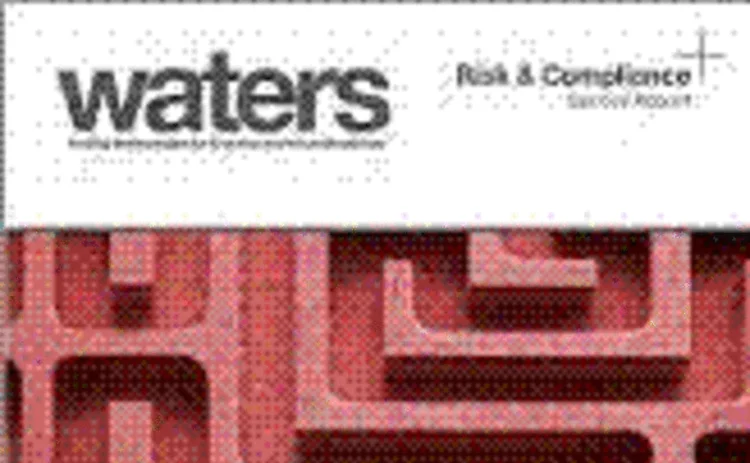Risk & Compliance special report

Click here to download the PDF
A Study of Inadequacy
Of all the business processes exposed by the recent financial crisis as being woefully inadequate, risk management is top of the list. But before the legions of risk mangers in buy- and sell-side land take offence to this assessment, I should add that pointing the finger of blame in their direction is as senseless as it is unwarranted.
You see, prior to financial crisis - which to all intents and purposes is as close to the perfect storm as the financial services industry is ever likely to get - issues like counterparty and liquidity risk were anything but industry-wide concerns. In fact, from a buy-side perspective, counterparty risk had historically always been a broker-related or sell-side consideration, which goes a long way to explaining how and why significant numbers of hedge funds were forced to close their doors when Lehman Brothers went belly-up, hot on the heels of Bear Stearns which failed in March 2008.
The sobering risk management lessons played out in the wake of the banks' sensational failures have already been sufficiently well documented in the pages of most financial journals, which means rehashing the recent past serves little purpose. What's far more useful to our industry is assessing current risk management practices with the view to developing the types of procedures to ensure that the deficiencies of the past stay in the past.
In this respect, what has become patently obvious over the past 18 months is the realization that, as buy- and sell-side firms overcome their inertia and start moving toward managing their risk on a close-to-real-time basis across business units, asset classes and geographical locations, data lies at the heart of the challenge. Managing risk in such a manner is the natural end point to which all risk professionals should aspire. And, even though that end point is still a long way off, it is none-the-less realistic and achievable.
But before we get carried away on a wave of pragmatism, even the most sanguine risk manager will concede that unless you can guarantee that all the data within your organization is clean, consistent and homogenized - and, perhaps most importantly, it is processed in close to real time so as to reflect up-to-the-minute changes in the market - aiming for that end point is an exercise in futility.
Only users who have a paid subscription or are part of a corporate subscription are able to print or copy content.
To access these options, along with all other subscription benefits, please contact info@waterstechnology.com or view our subscription options here: https://subscriptions.waterstechnology.com/subscribe
You are currently unable to print this content. Please contact info@waterstechnology.com to find out more.
You are currently unable to copy this content. Please contact info@waterstechnology.com to find out more.
Copyright Infopro Digital Limited. All rights reserved.
As outlined in our terms and conditions, https://www.infopro-digital.com/terms-and-conditions/subscriptions/ (point 2.4), printing is limited to a single copy.
If you would like to purchase additional rights please email info@waterstechnology.com
Copyright Infopro Digital Limited. All rights reserved.
You may share this content using our article tools. As outlined in our terms and conditions, https://www.infopro-digital.com/terms-and-conditions/subscriptions/ (clause 2.4), an Authorised User may only make one copy of the materials for their own personal use. You must also comply with the restrictions in clause 2.5.
If you would like to purchase additional rights please email info@waterstechnology.com
More on Trading Tech
RBC takes European traders to the Endgame
The Canadian bank’s complex execution algorithm, increasingly popular with traders stateside, is making landfall in Europe. But the region’s fragmented markets mean adoption is not simply a matter of plug-and-play.
Banks hope new axe platform will cut bond trading costs
Dealer-backed TP Icap venture aims to disrupt dominant trio of Bloomberg, MarketAxess and Tradeweb.
Editor’s Picks: Our best from 2025
Anthony Malakian picks out 10 stories from the past 12 months that set the stage for the new year.
The next phase of AI in capital markets: from generative to agentic
A look at some of the more interesting projects involving advanced forms of AI from the past year.
Will overnight trading in equity markets expand next year? It’s complicated.
The potential for expanded overnight trading in US equity markets sparked debate this year, whether people liked it or not.
WatersTechnology latest edition
Check out our latest edition, plus more than 13 years of our best content.
The total portfolio approach gains momentum: Building the right tech foundation for success
The rationale for the TPA, and the crucial role technology plays in enabling such an approach
Google, CME say they’ve proved cloud can support HFT—now what?
After demonstrating in September that ultra-low-latency trading can be facilitated in the cloud, the exchange and tech giant are hoping to see barriers to entry come down.








